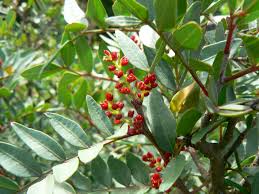Allelopathic effect of pistacia khinjuk leaf extracts on chenopodium album, physalis alkekengi and amaranthus retroflexus
Keywords:
Allelopathy, Pistacia khinjuk Leaf, Weed, Germination, Chenopodium Album, Amaranthus Retroflexus and Physalis AlkekengiAbstract
A weed is a term applied to any plant considered as one major problem in farm fields and gardens. Weeds cause serious damages to farmers per year, bringing about heavy losses in farm and garden yield. Thus, in order to contain the growth and spread of weeds, farmers have no way but using chemical weed killers known as herbicides. As chemical methods have had serious negative effects in recent decades, using allelopathies, combined with other species within intercropping systems, to control unwanted plants and providing a good cultivated setting has attracted great attention. To reduce using chemical herbicides in farms and garden and developing sustainable agriculture, this article studies the Allelopathic effects of Pistacia khinjuk leaf extract on seed germination of Chenopodium album, Physalis alkekengi and Amaranthus Retroflexus in Jahrom. The research indicated that the leaf extract from Pistacia khinjuk contains materials decreasing the growth parameters in Amaranthus Retroflexus. However, in Physalis Alkekengi and Chenopodium album L., any process of germination did not affected by the density of Pistacia khinjuk extract. Extract with high density reduced significantly the extent of seed germination by 95%. The results revealed that weeds have the same influence on various factors of growth, excluding weight and length of seedling. To put it another way, there is no significant difference between Physalis Alkekengi and Amaranthus Retroflexus with Chenopodium Album over some factors from germination rate to intermediate germination periods, germination speed, and length of their hypocotyls and radical roots. However, a significant difference is observed between them and Amaranthus Retroflexus L. in confident level of 95%.
References
Alipour, S.h., Filizadeh, Y., Montazeri, M., 2010. Investigation on the Allelopathic effects of Artemisia annua on weeds in corn fields. J. Weed Projects., 2(1), 69-83.
Dehdari, S., Jafari, M., 2009. Investigation on Allelopatic effects of Atriplex canescens(fourwing saltbush) on seed germination of salsola rigida. Pajouhesh Sazandegi., No 81, pp, 145 – 151.
Heydari, B., Extract, M.H., Enteshari, S.h., Shariat, A., 2003. Investigation on Allelopathic effects of methanol extract of Eucalyptus camaldulensis leaf on germination criteria of two weeds called Mountain Rye (Secale montanum) and Mallow (Malva sylvestris). J. Weed Ecol., 1(1), 23.
Jefferson, L.V., Penacchio, M., 2003. Allelopathic affects of foliage extracts from four Chenopodiaceae species on seed germination, J. Arid Env. 55(2), 275-285.
Karimi, H., 1995. Iran Weeds, Tehran University Press, First ed.
Kocacaliskan, I., Ceylan, M., Teriz, I., 2009. Effect of juglone on seedling growth in intact andcoatless seeds of cucumber (Cucumis sativus cv. Beith Alpha). Sci. Res. Essay., 4 (1), 039-041.
Masudi Khorasani, F., Hadadchi, G.h., Bagherani, N., Banayan Aval, M., 2005. Allelopathic effects of water extract from different organs of Sinapis arvensis L. in different density on some germination traits of Brassica napus L. J. Agr. Sci. Natural Res., 12(5), 145-158.
Mohamadi, N., Rajaei, P., Fahimi, H., 2012. Investigation on the Allelopathic effects of Eucalyptus leaf extract on morphological and physiological parameters of monocots and dicots. J. Biol., 25(3), 125-142.
Naghdi Badi, H., Omidi, H., Shams, H., Kian, Y., Dehghani Moshkani, M.R., Seyf Sahandi, M., 2009. Allelopathic effects of water extracts from Peganum harmala L. on seed germination and the growth of Purtulaca oleracea L. and Chenopodium album L. J. Med. Plants., 1(33)L 116-127.
Negahdar Saber, M.R, Fatahi, M., Nasirzadeh, A., 2007. Investigation on the appearance traits and finding the best germination method of Pistacia atlantica seeds. Iran Sci. J. Jungle Spruce., 15(1), 11-18.
Omidi, H., Tahmasebi Sarvestani, Z., Ghalavand, A., Modarres-Sanavi, S.A.M., 2005. Evaluation of tillage systems and row distances on grain yield and oil content in two canola (Brassica napus) cultivars. Iran. J. Crop Sc., 7 (2), 97-111.
Rashed Mohasel, M.H., Qarakhloo, J., Rastgoo, M., 2009. Allelopathic effect of safran (Crocus sativus) leaf extract on redroot pigweed and common goosefoot. Iran. J. Crop Res.,7(1),53-61.
Rouhi, A., Tajbakhsh, M., Saeidi, M.R., Nikzad, P., 2009. Allelopathic effects of water extract of Juglans regia on some traits of germination and seedling growth of Triticum aestivum, Triticum aestivum, and Lactuca sativa. Iran. J. Farm. Res., 7(2), 457-464.
Tawaha, K., Feras, Q.A., Mohammad, G., Mohammad, M., 2007. Tamam El-Elimat. Antioxidant activity and total phenol content of selected Jordanian plant species. Food Chem., 104, 1372 – 8.
Terzi, I., Kocaçaliskan, I., Benlio, l.O., Solak, K., 2003. Effects of juglone on growth cucumber seedlings with respect to physiological and anatomical parameters. Acta Physiol. Plant., 25, 353-356.
Vahedi, A., 2005. Weeds (Scientific Fight against Weeds), Islamic Azad Univ. Press, First ed,
Yamamoto, A., Turgeon, J., Duich, J.M., 1997. Field emergence of solid matrix seed primed Turf grasses. Crop sci., 37, 220 - 5.
Zareh, A., Heydarian Ardakani, H., Ebadikhah Dehali, D., 2010. Investigation on the Allelopathic effects of Helianthus annus on germination and primary growth of Amaranthus retrofelexus. Fifth Nat. Congress of New Ideas in Agr. Islamic Azad Univ. Khorasgan.
Zohary, D., 1996. Taxonomy of the genus Pistacia L. Pistacia genetic recourses. Int. workshop., 1-11.

Published
How to Cite
Issue
Section
Copyright (c) 2014 Nehle Taghvaeefard, Hamid Sadeghi

This work is licensed under a Creative Commons Attribution-NonCommercial-NoDerivatives 4.0 International License.



